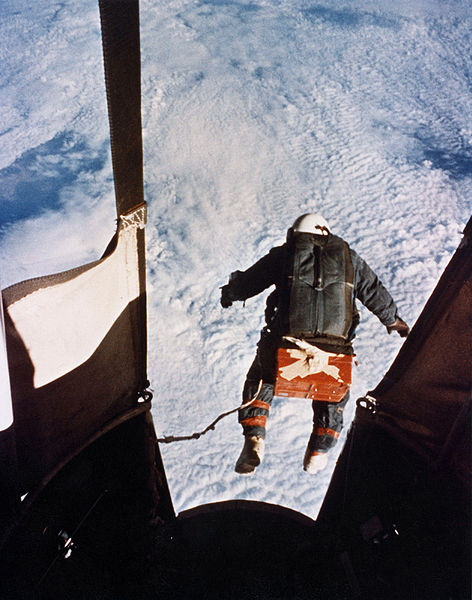 So did you hear about this guy who rode a balloon out into space — more than 100,000 feet up! — and jumped from it, hurtling towards the earth at hundreds of miles per hour before safely parachuting to the ground?
So did you hear about this guy who rode a balloon out into space — more than 100,000 feet up! — and jumped from it, hurtling towards the earth at hundreds of miles per hour before safely parachuting to the ground?
His name is Joseph Kittinger. He made his astounding leap from the US Air Force experimental craft Excelsior III some 52 years ago, on August 16, 1960. You may have seen Kittinger recently (or at least heard his voice), as he was in charge of mission control communications for Felix Baumgartner’s successful space jump — which finally, after all these years, broke Kittinger’s records for skydiving altitude and skydiving speed.
It’s less likely that you’ve heard of Nick Piantinida, who broke Kittinger’s record for high-altitude ballooning on February 6, 1966, reaching 123,500 feet in his balloon named Strato Jumper II. Unfortunately, Piantinida’s attempts at beating Kittinger’s skydiving record were unsuccessful; he was severely injured in his final attempt and died shortly thereafter. But his ballooning record held for some 46 years, until earlier this week when Baumgartner topped him by less than a mile.
All of which raises an interesting question about Baumgartner’s amazing achievement: why now? Why has it taken all these years to add 4500 feet to Piantinida’s altitude and 115 miles per hour to Kittinger’s speed to finally deliver the ultimate, supersonic, feat of skydiving?
The reason it’s taken so long is that we’ve been waiting for someone willing to put up the money–someone willing to make it happen. I have no doubt that the Air Force could have broken Kittinger’s record decades ago if they had seen any point in doing so. But they aren’t in the business of performing crazy stunts and setting records. Red Bull, on the other hand, is a huge promoter of extreme sports. They are all about the crazy stunts. In this project they saw an outstanding opportunity to build awareness of their brand, so they were happy to pony up the cash needed to make Baumgartner’s jump possible.
Expect to see a lot more of this sort of thing. As de-industrialization continues to push capabilities that once belonged only to large governments into the hands of smaller enterprises (think Red Bull in this story, but also think SpaceX) or even individuals, the relentless compounding of improvements opens up all kinds of possibilities. As with the introduction of the cardboard bicycle, most of the elements needed to make Baumgartner’s jump possible were already in place. All that was needed were a few supporting bits of technology and the will to make it happen.
The will is the real clincher. If you have enough of that, you can get the technical stuff working. In this world there has always been a lot more will to do extraordinary things than capability to support that will. What we are witnessing today is the early stages of a capability explosion. This will inevitably lead to a possibility explosion — so many people doing so many extraordinary things that we will have to constantly recalibrate what we mean by “extraordinary.”
How long before anyone who wants to can recreate Baumgartner’s amazing jump? And how long before some corporation or individual recreates Neil Armstrong’s giant leap?